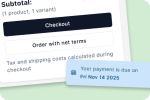Invoice date is when an invoice is created and issued to a buyer, while due date is the deadline by which payment must be received. Understanding the difference between invoice date and due date is crucial for maintaining healthy business relationships, managing cash flow effectively, and ensuring legal compliance.
Whether you’re a small business owner, accountant, or procurement manager, recognizing how these two dates function independently yet interdependently can prevent payment disputes, late fees, and financial forecasting errors. In this article, you’ll learn:
- Key Definitions: Invoice Date and Due Date
- Why Invoice Date and Due Date Matter in Business
- How to Calculate Invoice Due Date Using Payment Terms
- Best Practices for Invoice Management
- Real-World Examples and Scenarios of Invoice Date and Due Date
- Emerging Trends in Wholesale Pricing and Payment Terms
Key Definitions: Invoice Date and Due Date
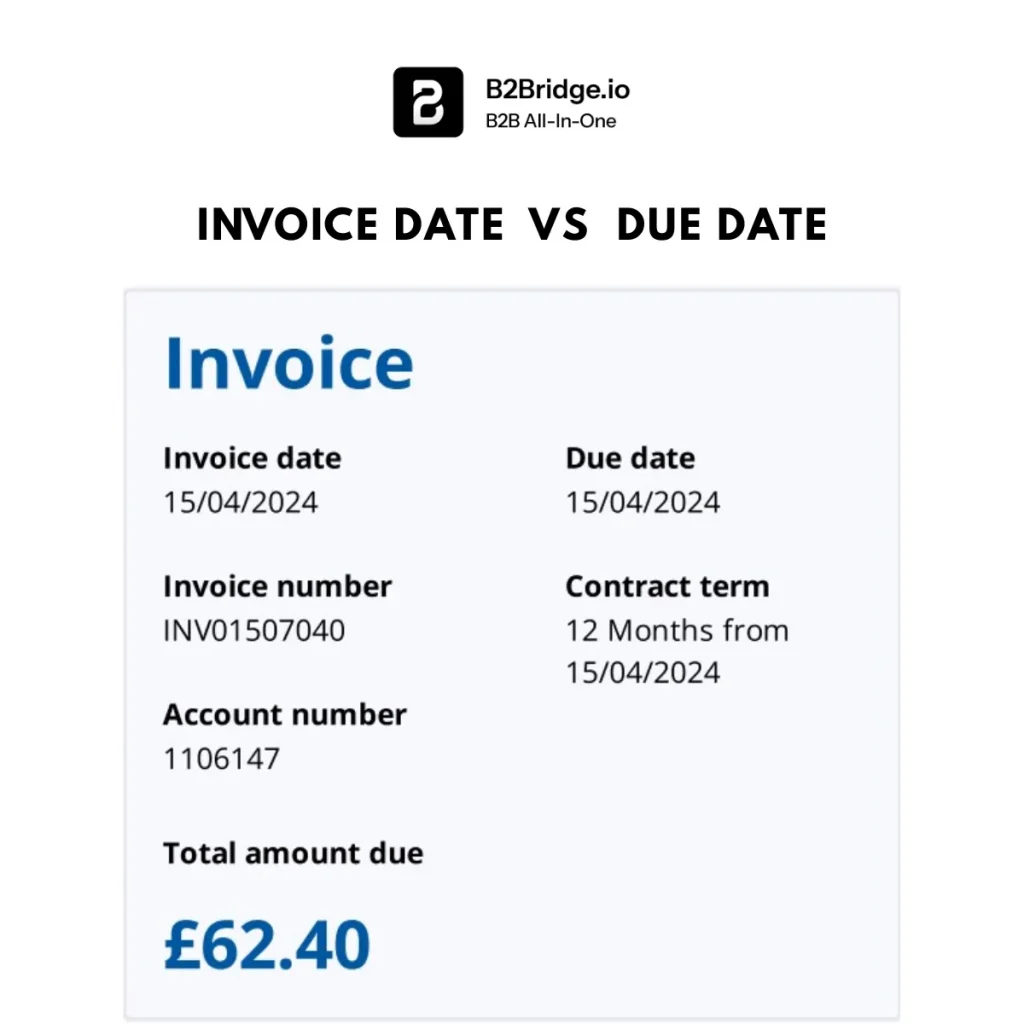
What Is an Invoice Date?
The invoice date is the specific date when a seller creates and issues an invoice to a buyer for goods delivered or services rendered. This date serves as the official timestamp for when the transaction was documented and marks the beginning of the payment period.
How to find invoice date?
The invoice date typically appears at the top of the invoice document, often labeled as “Invoice Date,” “Date,” or “Issue Date.” It’s usually positioned near the invoice number and seller’s contact information.
This date is critical for accounting purposes as it determines when the sale is recorded in financial books, regardless of when payment is received. The invoice date also serves as the starting point for calculating payment terms and establishing when the payment clock begins ticking.
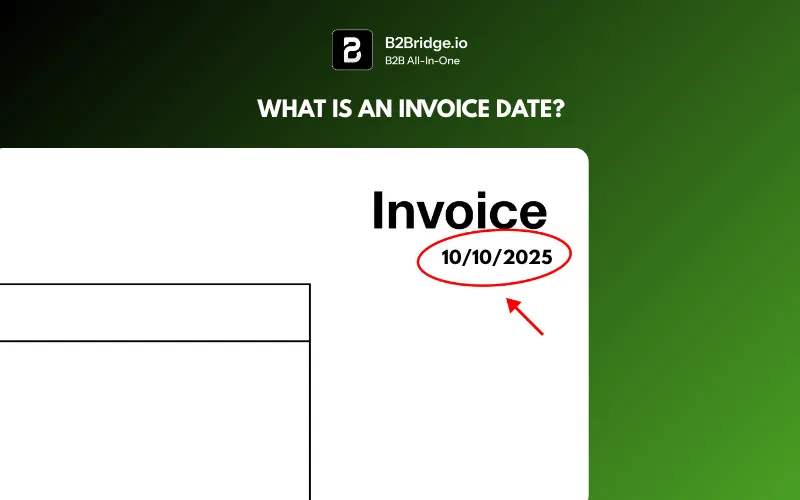
What Is a Due Date?
The due date represents the final day by which payment must be received to comply with the agreed-upon payment terms. This deadline is calculated by adding the payment terms (such as Net 30, Net 60, or Net 90) to the invoice date. Missing the due date often triggers consequences including late payment fees, interest charges, damaged credit relationships, or even legal action in severe cases.
The due date protects both parties: it gives buyers a clear timeline for payment planning while providing sellers with a definitive expectation for when funds will arrive. In accounting systems, the due date helps businesses forecast cash flow, manage working capital, and prioritize collection efforts.

Core Differences Between Invoice Date and Due Date
To clearly distinguish these two critical dates, consider the following key differences:
- Purpose: Invoice date marks the transaction recording and documentation, while due date establishes the payment deadline
- Timing: Invoice date occurs first and is fixed at issuance; due date comes later and depends on agreed payment terms
- Calculation: Invoice date requires no calculation – it’s simply the issuance date; due date is calculated by adding payment terms to the invoice date
- Accounting impact: Invoice date determines when revenue is recognized; due date affects accounts receivable aging and cash flow projections
- Legal significance: Invoice date proves when goods/services were provided; due date establishes contractual payment obligations
- Flexibility: Invoice date cannot be changed once issued; due date may be negotiable under certain circumstances
- Business function: Invoice date triggers the billing cycle; due date triggers collection activities if unpaid
Transform your B2B store with B2Bridge.
Discover how B2Bridge can transform your wholesale business.
Schedule a demo today to see our payment management tools in action.
Why Invoice Date and Due Date Matter in Business
Role in Accounting and Cash Flow Management
Both invoice date and due date play pivotal roles in maintaining accurate financial records and projecting cash flow. The invoice date determines when a sale is recognized in accounting books, following accrual accounting principles where revenue is recorded when earned, not when cash is received. This impacts profit and loss statements, tax obligations, and revenue reporting periods.
The due date, meanwhile, is essential for cash flow forecasting. By tracking due dates across all outstanding invoices, businesses can predict when payments will arrive, plan for upcoming expenses, and identify potential cash shortages before they become critical. Companies with strong due date management typically maintain healthier working capital ratios and can make more informed decisions about investments, hiring, and inventory purchases.
According to financial management best practices, businesses should monitor their Days Sales Outstanding (DSO) – the average number of days it takes to collect payment after a sale – which directly correlates with how effectively due dates are set and enforced.
Legal Significance and Enforcement
From a legal standpoint, the invoice date establishes when the contractual obligation was created, which can be crucial in disputes about warranty periods, return policies, or statute of limitations issues. The due date, however, carries direct legal weight regarding payment enforcement.
Many jurisdictions require invoices to clearly display both dates, and the due date specifically determines when a debt becomes legally overdue. Once the due date passes without payment, creditors may have the right to charge late fees (if specified in the original agreement), report late payments to credit bureaus, or pursue collection activities including legal action.
The due date also serves as evidence in breach of contract cases and can affect the calculation of interest on overdue amounts. Businesses operating internationally should be aware that some countries have specific regulations about maximum payment terms and mandatory payment deadlines for certain industries.
Effect on Customer and Vendor Relationships
Clear, reasonable invoice dates and due dates foster trust and transparency in business relationships. When due dates are prominently displayed and calculated fairly, customers can plan their cash flow accordingly and avoid unpleasant surprises. This transparency reduces disputes, phone calls for clarification, and the need for payment reminders.
Conversely, unclear due dates or unrealistic payment terms can strain relationships, leading to delayed payments not from unwillingness but from confusion or poor planning. Vendors who consistently respect agreed-upon invoice dates and provide reasonable due dates are more likely to maintain long-term partnerships and receive priority payment when customers face cash constraints.
In wholesale and B2B contexts, the relationship between these dates often becomes a negotiation point, with established partners sometimes earning extended payment terms as a reflection of mutual trust.
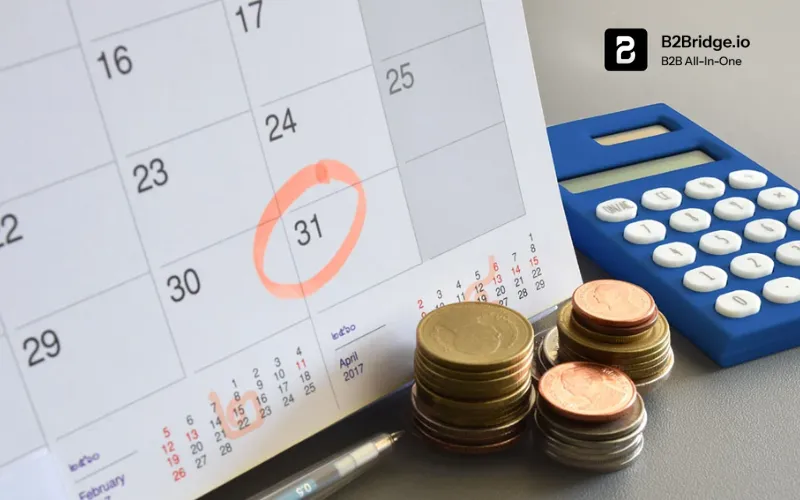
Invoice Processing: How to Automate and Reduce Manual Invoice Processing
Automating invoice processing is an effective way for businesses to reduce manual effort, minimize errors, and accelerate payment cycles. This not only enhances operational efficiency but also strengthens supplier relationships and cash flow management. The automation process typically involves using software tools that capture, validate, approve, and schedule invoice payments with minimal human intervention.
Key steps to automate and reduce manual invoice processing include:
Implement Optical Character Recognition (OCR) and AI-driven Data Capture
Automation software uses OCR technology to scan invoices and extract key information such as invoice date, due date, amounts, and vendor details accurately. AI further improves accuracy by cross-checking data against purchase orders or contracts to detect discrepancies.
Automate Invoice Approval Workflows
Define approval hierarchies and automate the routing of invoices to appropriate personnel for timely verification and authorization. This eliminates delays caused by manual handoffs and allows faster decision-making.
Integrate Automation with Enterprise Resource Planning (ERP) and Accounting Systems
Seamless integration ensures invoice data flows directly into accounting books and payment systems, reducing duplicate data entry and manual reconciliations.
Set Up Automated Payment Scheduling and Reminders
Once invoices are approved, software can automatically schedule payments based on due dates, helping avoid late fees and take advantage of early payment discounts. Automated reminders notify teams and vendors of upcoming or overdue payments.
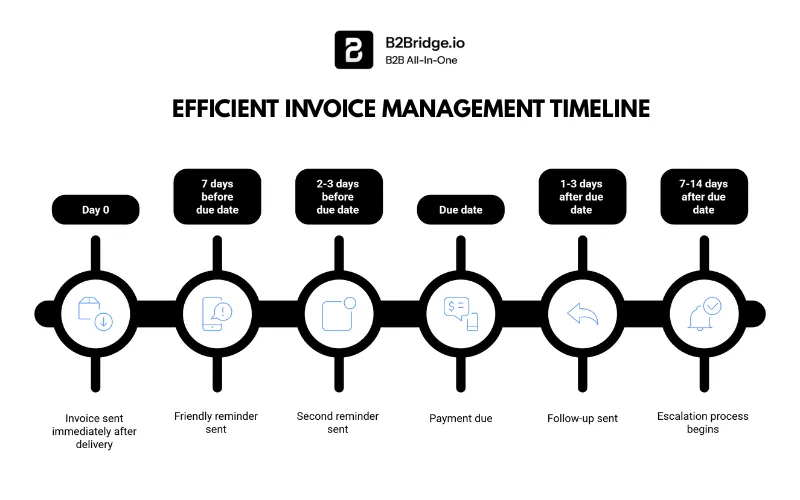
Gain Real-Time Visibility and Reporting
Automation platforms provide dashboards that display invoice statuses, identify bottlenecks, and offer insights on payment trends for better cash flow forecasting and audit readiness.
Benefits of automating invoice processing include faster processing times, enhanced accuracy, reduced risk of fraud due to built-in validation, lower administrative costs, and improved compliance with regulatory requirements.
By adopting automation, businesses can shift their finance teams’ focus from routine manual tasks to higher-value activities, supporting growth and operational excellence.
How to Calculate Invoice Due Date Using Payment Terms
Understanding Net Payment Terms (Net 30, Net 60, Net 90)
Net payment terms are standardized credit periods that define how many days a buyer has to pay an invoice after the invoice date. The most common terms include:
- Net 30: Payment is due 30 days after the invoice date
- Net 60: Payment is due 60 days after the invoice date
- Net 90: Payment is due 90 days after the invoice date
Some businesses also use “Net 10,” “Net 15,” or other variations depending on industry norms and cash flow needs. The “net” designation means the full invoice amount is due within the specified period with no discounts applied. Additional terms like “2/10 Net 30” offer early payment discounts – in this example, a 2% discount if paid within 10 days, otherwise the full amount is due in 30 days.
These standardized terms simplify business transactions, as both parties immediately understand the payment timeline without lengthy negotiations for each invoice.
Step-by-Step Examples on Calculating Due Dates
Calculating due dates from invoice dates is straightforward once you understand the payment terms:
Example 1: Basic Net 30 Calculation
- Invoice Date: January 15, 2025
- Payment Terms: Net 30
- Calculation: January 15 + 30 days = February 14, 2025
- Due Date: February 14, 2025
Example 2: Net 60 Across Month Boundaries
- Invoice Date: March 20, 2025
- Payment Terms: Net 60
- Calculation: March 20 + 60 days = May 19, 2025
- Due Date: May 19, 2025
Example 3: Net 90 with Year Boundary
- Invoice Date: November 15, 2024
- Payment Terms: Net 90
- Calculation: November 15 + 90 days = February 13, 2025
- Due Date: February 13, 2025
Example 4: Early Payment Discount Terms
- Invoice Date: April 1, 2025
- Payment Terms: 2/10 Net 30
- Discount Due Date: April 11, 2025 (invoice date + 10 days for 2% discount)
- Final Due Date: May 1, 2025 (invoice date + 30 days for full payment)
Important considerations: Always count calendar days, not business days, unless specifically stated. When the due date falls on a weekend or holiday, standard practice typically considers payment on the next business day as timely, though this should be clarified in payment agreements.
Whether you’re setting up your first B2B Shopify store or improving an existing wholesale operation, B2Bridge helps you create a smooth, professional buying experience that meets your customers’ expectations.
Start Your Free Trial | Schedule a Demo | View B2Bridge Pricing Plans | View Success Stories
Factors Influencing Setting the Due Date
While standard net terms provide a framework, several factors influence how businesses set their due dates:
Industry standards: Retail businesses often expect faster payment (Net 15 or Net 30), while construction and manufacturing industries commonly use Net 60 or Net 90 due to project timelines and cash flow patterns.
Customer creditworthiness: Established customers with strong payment histories may receive more favorable terms (longer due dates), while new or high-risk customers might be required to pay upon receipt or within shorter periods.
Invoice amount: High-value invoices might warrant longer payment terms to accommodate buyer cash flow, while smaller invoices may have shorter due dates.
Competitive pressure: If competitors offer Net 60 terms, you may need to match those terms to remain competitive, even if you’d prefer shorter payment cycles.
Your cash flow needs: Businesses with tight cash flow require shorter due dates to maintain operations, while those with strong reserves can afford to extend longer terms as a relationship-building tool.
Seasonal considerations: Businesses with seasonal revenue patterns might adjust due dates to align with when customers are most likely to have available cash.
Best Practices for Invoice Management
Effective invoice management is crucial for maintaining healthy cash flow, fostering positive business relationships, and ensuring operational efficiency. Implementing best practices helps businesses reduce errors, avoid payment delays, and streamline financial processes.
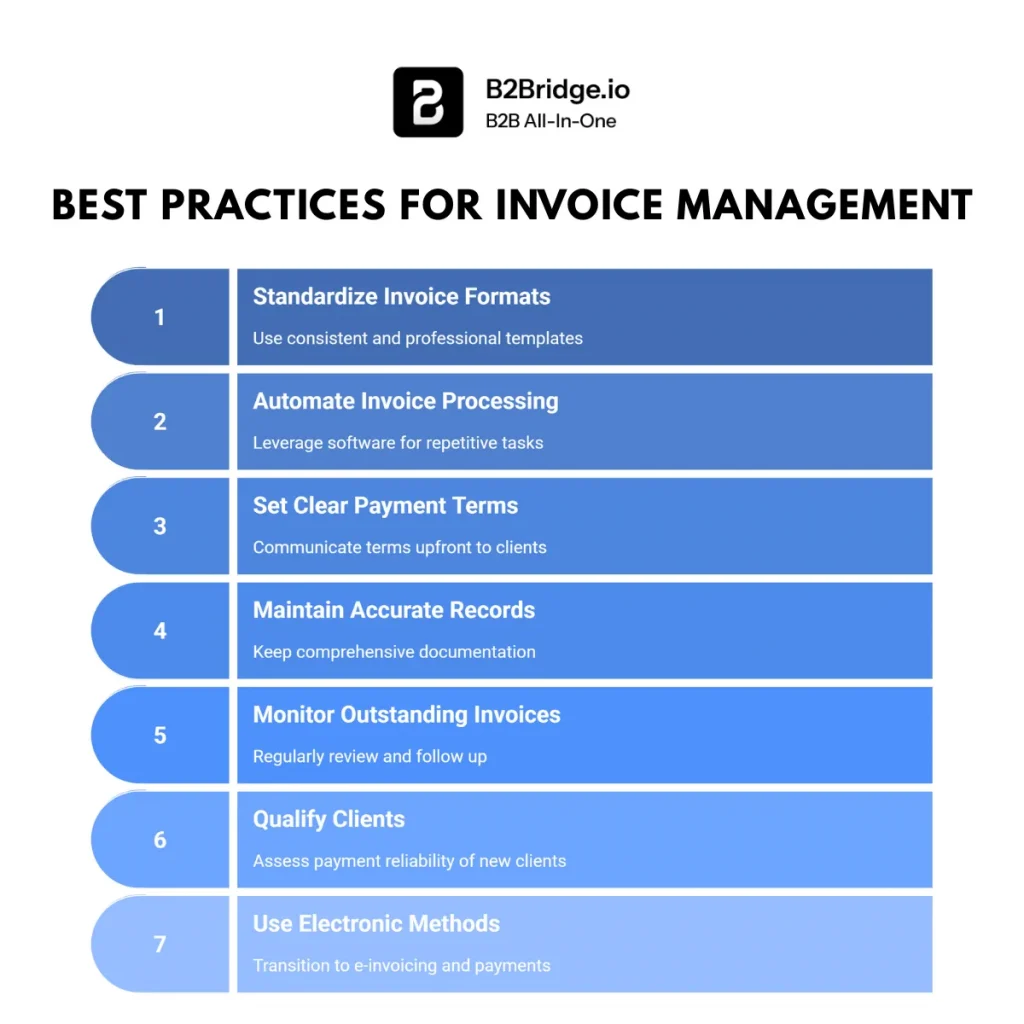
Here are key practices to consider:
Standardize Invoice Formats
Use consistent and professional invoice templates that clearly display essential details such as invoice number, invoice date, due date, itemized charges, and payment terms. Standardization fosters familiarity for clients and speeds up payment processing.
Automate Invoice Processing
Leverage invoice management software to automate repetitive tasks such as data entry, invoice generation, and payment reminders. Automation reduces human errors, accelerates invoicing cycles, and frees finance teams for strategic work.
Set Clear Payment Terms Upfront
Establish and communicate explicit payment terms, including due dates and accepted payment methods, before services are rendered or goods are delivered. Clear terms prevent confusion and encourage timely payments.
Maintain Accurate Records
Keep comprehensive records of all invoices, payments received, and related correspondence. Organized documentation aids tracking, reconciliations, and dispute resolution while supporting audit compliance.
Monitor and Follow Up on Outstanding Invoices
Implement a system to regularly review unpaid invoices and send timely reminders to clients. Proactive follow-up minimizes late payments and helps maintain steady cash flow.
Qualify Clients Before Engagement
Assess the payment reliability of new clients, especially for large or long-term contracts. Performing credit checks or requesting deposits mitigates risks of non-payment.
Use Electronic Invoicing and Payment Methods
Transition to e-invoicing to accelerate delivery and processing of invoices. Encourage electronic payments to shorten collection cycles and reduce administrative costs.
Real-World Examples and Scenarios of Invoice Date and Due Date
Understanding how invoice dates and due dates function across different industries illuminates their practical application:
Retail Supplier Scenario
- A clothing wholesaler ships inventory to a boutique on June 1, 2025
- Invoice Date: June 1, 2025
- Payment Terms: Net 30
- Due Date: July 1, 2025
- The retailer has one month to sell some inventory and generate cash before payment is due, helping them manage working capital
Professional Services Example
- A consulting firm completes a project on August 15, 2025
- Invoice Date: August 15, 2025
- Payment Terms: Due Upon Receipt
- Due Date: August 15, 2025
- Many service businesses use “Due Upon Receipt” for immediate payment, though in practice, this typically means payment within 7-14 days
Manufacturing with Extended Terms
- A machinery manufacturer delivers equipment on September 10, 2025
- Invoice Date: September 10, 2025
- Payment Terms: Net 90
- Due Date: December 9, 2025
- Large capital purchases often include extended terms, recognizing that buyers need time to install, test, and generate revenue before paying
Subscription Software Business
- A SaaS company bills annually on October 1, 2025
- Invoice Date: October 1, 2025
- Payment Terms: Net 15
- Due Date: October 16, 2025
- Subscription businesses often use shorter terms since the service is ongoing rather than a one-time delivery
Wholesale Distribution with Early Payment Incentive
- A food distributor delivers products on November 5, 2025
- Invoice Date: November 5, 2025
- Payment Terms: 3/10 Net 45
- Discount Due Date: November 15, 2025
- Final Due Date: December 20, 2025
- The 3% discount encourages quick payment, benefiting the distributor’s cash flow while saving the buyer money
Emerging Trends in Wholesale Pricing and Payment Terms
The wholesale industry is experiencing a significant shift in how payment terms and due dates are structured. Traditional rigid payment terms are giving way to more flexible, relationship-based approaches that recognize the diverse needs of modern B2B buyers.
Dynamic payment terms are becoming increasingly popular, where due dates adjust based on order size, customer loyalty, or seasonal factors. For example, a wholesale supplier might offer Net 30 as standard terms but extend to Net 60 for customers who consistently order above certain thresholds or during slower business periods when buyers need extra cash flow cushion.
Technology is also transforming payment term management. Modern B2B Ecommerce platforms now automate the calculation of due dates, send automated payment reminders as due dates approach, and even offer flexible payment options like split payments or installment plans for large orders. These innovations reduce administrative burden while improving collection rates.
Early payment programs and supply chain financing are gaining traction as well. Some suppliers now offer tiered discount structures (for instance, 5% for immediate payment, 3% for 10 days, or standard Net 30) that incentivize early payment without pressuring customers. Meanwhile, supply chain financing arrangements allow buyers to extend their payment terms while suppliers receive early payment from financial institutions, benefiting both parties.
The COVID-19 pandemic accelerated the adoption of flexible payment terms as businesses sought to maintain relationships during cash flow disruptions. This flexibility has persisted, with many wholesalers now viewing payment terms as a strategic tool for customer retention and acquisition rather than a rigid policy.
How B2Bridge Supports Seamless Payment Term Management
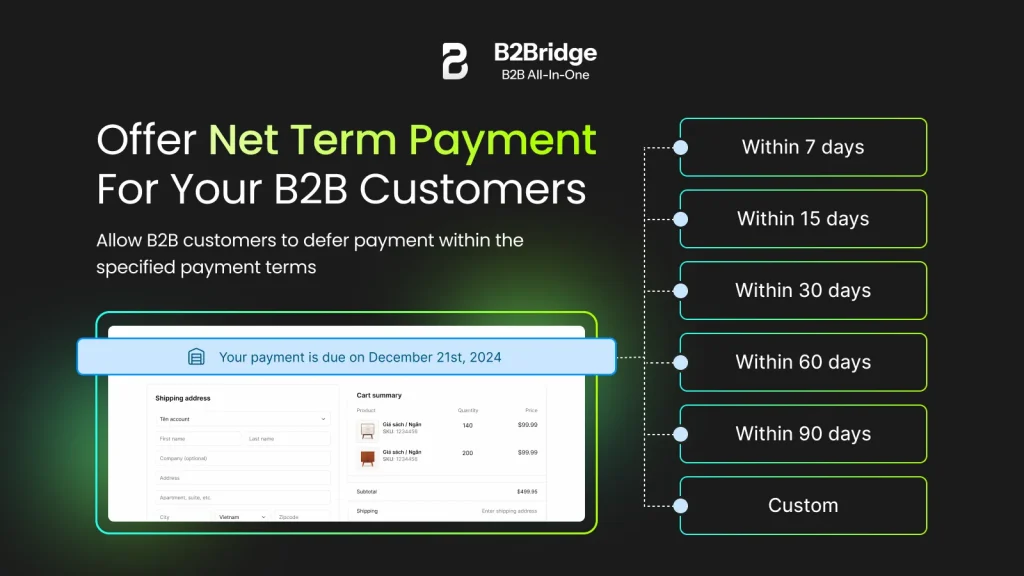
Simplify Wholesale Management with B2Bridge
B2Bridge provides wholesale businesses with comprehensive tools to manage invoice dates, due dates, and payment terms effortlessly. The app automates invoice generation with accurate date calculations, ensuring every invoice clearly displays both the issue date and due date based on your configured payment terms. This automation eliminates manual errors and ensures consistency across all customer transactions.
Automate Registration, Pricing, and Order Handling
B2Bridge integrates payment term management into the entire order-to-cash cycle. When customers register, you can automatically assign payment terms based on credit checks or business rules. When orders are placed, the system applies the correct terms.
Deliver a Seamless B2B Buyer Experience
Your customers benefit from B2Bridge’s transparency. They can log into their portal to view all invoices, see due dates clearly, and make payments electronically. Automated reminders ensure they never miss a payment unintentionally, protecting your relationship while improving your collection rates.
Close More Deals with Negotiation Tools
B2Bridge enables flexible payment negotiations at the point of sale. Your sales team can offer extended terms to close larger deals, with the system automatically calculating new due dates and tracking the custom arrangements. This flexibility helps you win competitive bids while maintaining financial control.
FAQs about Invoice Date vs. Due Date
The invoice date is when the invoice is created and issued, marking the start of the payment period. The due date is the deadline by which payment must be received, calculated by adding the payment terms (like Net 30) to the invoice date. The invoice date documents the transaction, while the due date enforces the payment obligation.
No, the purchase date and invoice date can differ. The purchase date is when the buyer commits to the purchase (order date), while the invoice date is when the seller bills for the transaction. In many cases, especially with immediate shipping, these dates might be the same or very close, but for pre-orders, backorders, or service contracts, the purchase date might precede the invoice date by days, weeks, or even months.
To process an invoice, verify its accuracy, match it with the purchase order and delivery receipt, obtain necessary approvals, record the details in your accounting system, schedule payment according to agreed terms, and confirm completion once payment is sent and received.
Not necessarily. The invoice date is the date the invoice is issued, which may occur on the purchase date, delivery date, or after service completion, depending on business practices and industry norms. For retail transactions, they’re often the same day. For B2B transactions, the invoice date typically aligns with delivery or service completion rather than the initial order date.
Net payment terms directly determine the due date by specifying how many days after the invoice date payment is required. Net 30 means 30 days from invoice date, Net 60 means 60 days, and so on. The longer the net terms, the later the due date, which impacts cash flow for both buyer and seller.
Yes, due dates can be modified after issuance, but this typically requires mutual agreement between buyer and seller. Common situations include payment plan negotiations, financial hardship accommodations, or dispute resolutions. Any changes should be documented in writing (often called a payment arrangement or amendment) and reflected in updated invoices or credit memos to maintain clear accounting records.
Consequences of late payment vary based on the agreement but may include late payment fees (typically 1-2% per month), interest charges on the overdue amount, suspension of credit privileges, holds on future orders, negative impacts on business credit scores, and ultimately collection agency involvement or legal action. The specific consequences should be outlined in the original payment terms or contract.
Due dates are critical for wholesale cash flow management. Shorter due dates (Net 15 or Net 30) accelerate cash collection, improving working capital but potentially reducing competitiveness. Longer due dates (Net 60 or Net 90) make your offering more attractive to buyers but tie up your cash longer.
Conclusion
The distinction between invoice date and due date may seem straightforward, but their proper management forms the foundation of healthy business finances and strong customer relationships. The invoice date marks the beginning of the payment journey, documenting when goods or services were provided and revenue was earned. The due date establishes clear expectations, protects both parties’ interests, and enables effective cash flow planning.
For businesses looking to streamline their invoice and payment term management, leveraging modern B2B Shopify Apps like B2Bridge transforms what was once a manual, error-prone process into an automated system that scales with growth. By clearly communicating both dates, setting appropriate payment terms, and using technology to automate tracking and reminders, businesses can improve collection rates, reduce disputes, and maintain the financial stability needed to thrive in competitive markets.
Hi, I’m Ha My Phan – an ever-curious digital marketer crafting growth strategies for Shopify apps since 2018. I blend language, logic, and user insight to make things convert. Strategy is my second nature. Learning is my habit. And building things that actually work for people? That’s my favorite kind of win.


